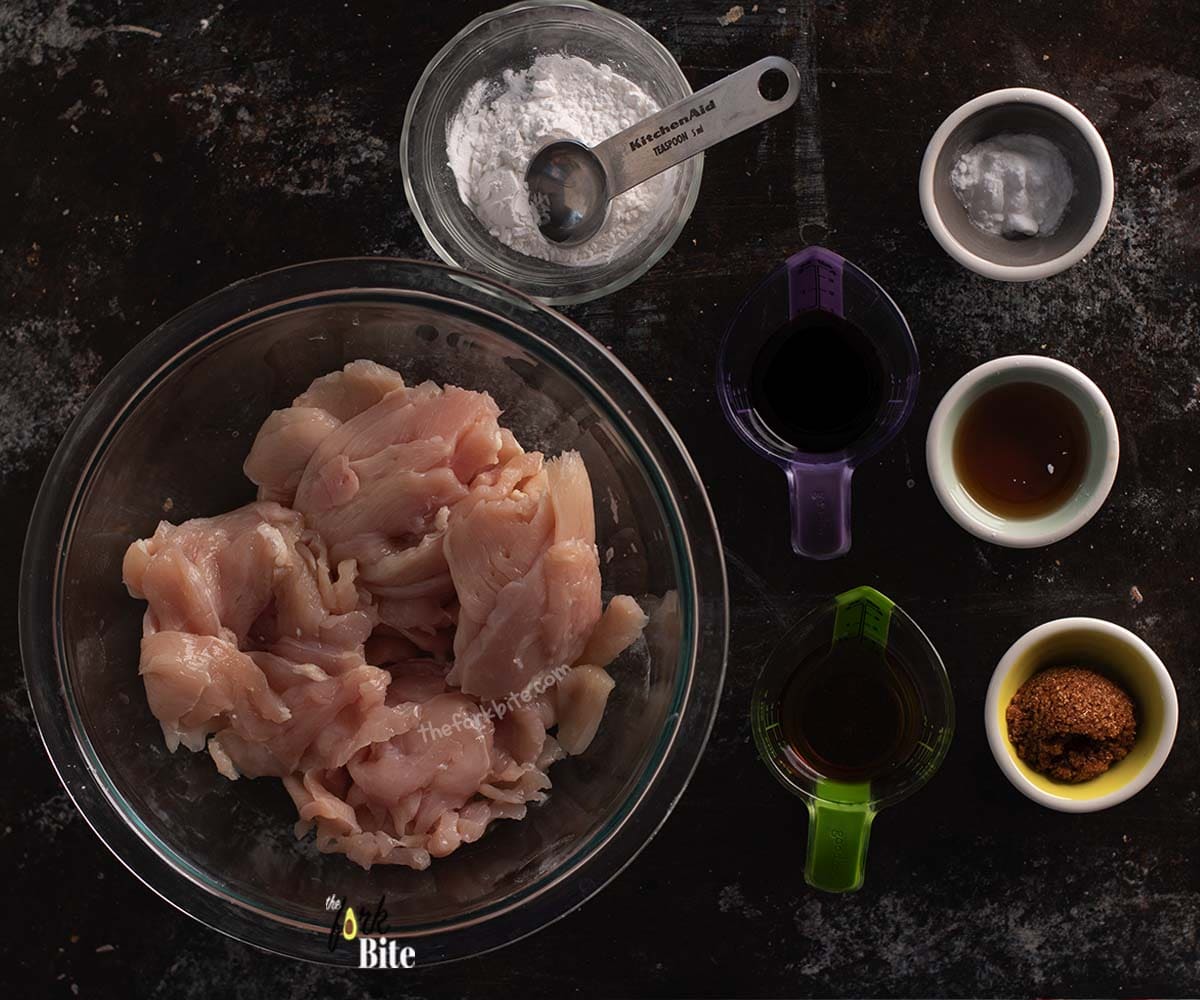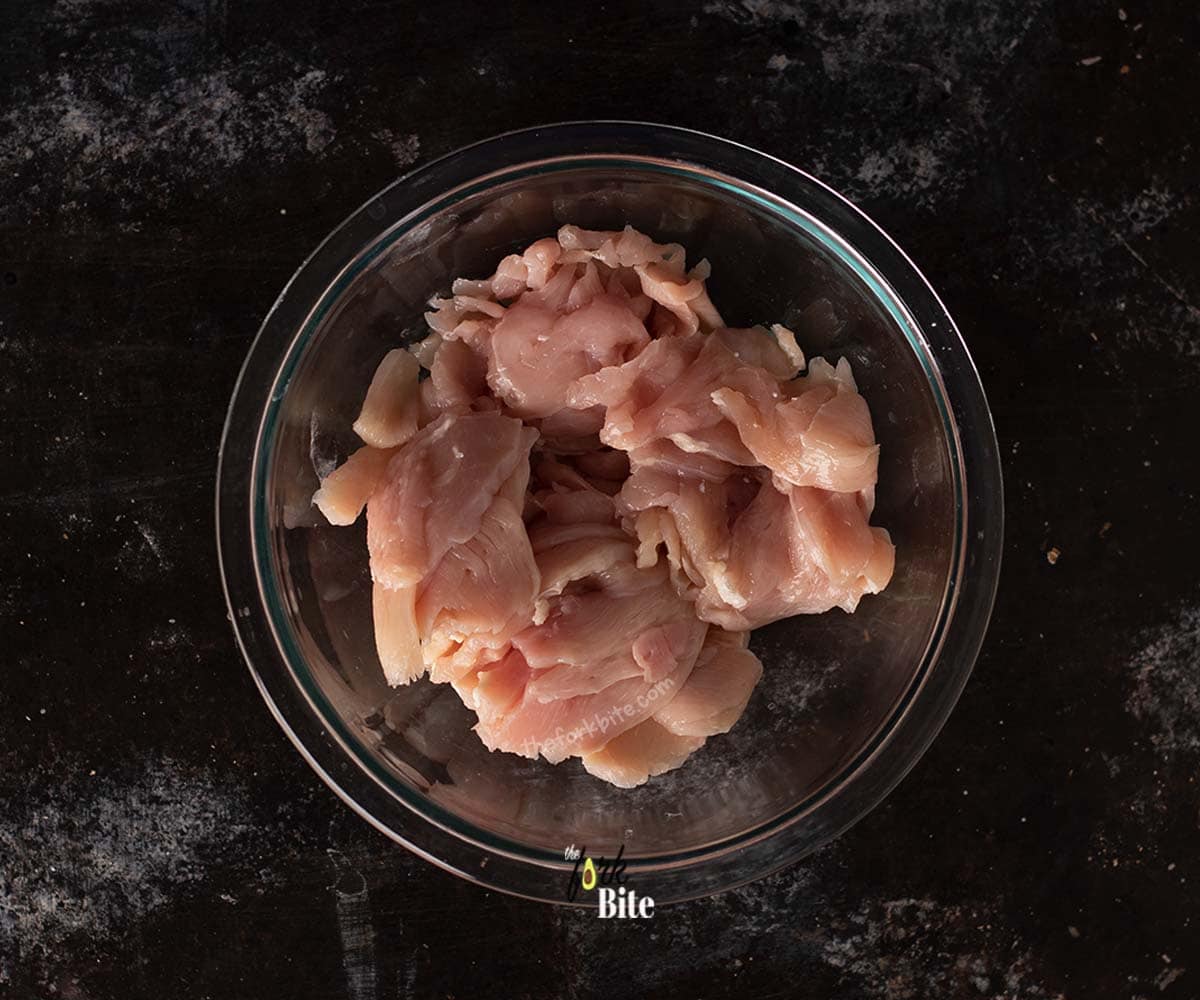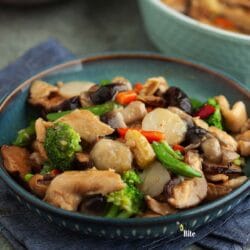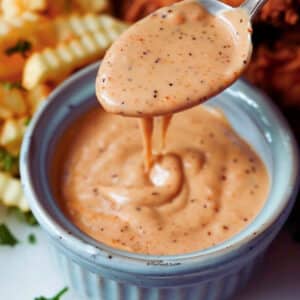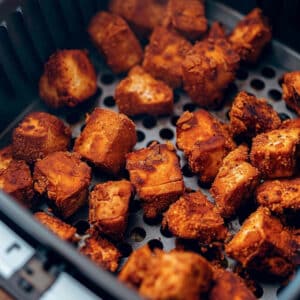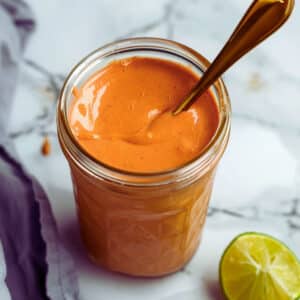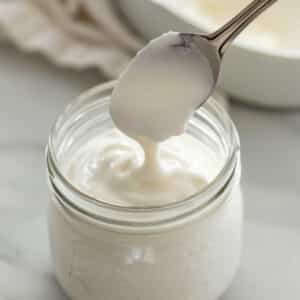This PF Changs Moo Goo Gai Pan copycat recipe is a yummy combination of chicken meat and mushrooms, stir-fried with a delicate, clear, tasty sauce.
This simple chicken and vegetable stir-fry can be cooked in less than 30 minutes.
The majority of us have been to eat in Chinese restaurants often enough to become familiar with dishes like Peking Duck and Sesame Chicken.
Even so, there are still a few dishes we spot on the menus that, although we might recognize them, we have no idea of what they are. Moo Goo Gai Pan is one such item.
Jump to:
Watch the video
Before we go into the details of Moo Goo Gai Pan, let's go over some of the ones we do know.
Chow Mein
In the Chinese language, Chow Mein means "fried noodles," and unsurprisingly, that is what is at the heart of this recipe.
Most of the time, when you spot Chow Mein on the menu, you can expect to be served a stir-fried dish of noodles, with meat, poultry, or shrimp, plus celery, onion, and some other veggies.
Plus liberal dosing of soy sauce. But it shouldn't be confused with Lo Mein.
Lo Mein is a dish whereby the egg noodles are boiled, then added to the other ingredients, stir-fried, just before serving. So the noodles are soft and succulent.
With Chow Mein, the boiled noodles are stir-fried along with the veggies, so before you add the sauce, the noodles are crispy. After the sauce has been added, they soften and take on a more chewy texture.
So, to avoid any disappointment when you order Chow Mein in a restaurant, ask the server if the noodles have been fried or only boiled.
Some restaurants don't bother to differentiate on their menus between Chow or Lo Mein, so ask the question, just to be sure.
Egg Foo Young
Basically, Egg Foo Young is a Chinese omelet with some veggies and protein (if required) added, plus some seasoning and a gravy made from chicken broth, soy sauce, and Chinese rice wine.
The ingredients can be anything you like, such as bean sprouts, cabbage, carrots, mushrooms, onion, etc. If you are more of a carnivore, you can add some meat, poultry, or shrimp.
Moo Shu
Moo Shu has become something of a staple for many Americans. It originates from North China, and its ingredients include pork, bok choy, celery, eggs, mushrooms, and something called mù xũ rōu, which are edible daylily buds.
Everything is wok-fried together with a mild peppery sauce. Traditionally, it is eaten wrapped in Mandarin pancakes, but these are an extra in some Chinese restaurants.
Kung Pao
Szechuan cuisine is a delicious style of cooking that originates from southwest China. Kung Pao Chicken is a hot and spicy dish typical of the region, but another version of the recipe is General Tso's Chicken.
It is an American hybrid that includes added sweetness.
Typically made with chunks of chicken, bean sprouts, garlic, ginger, green peppers, scallions, hot chili peppers, and peanuts, the US version (General Tso's) omits Szechaun peppercorns, which are a main ingredient of the original Chinese Kung Pao dish.
It is served with a garnish of peanuts or cashews.
What is moo goo gai pan?
While the name Moo Goo Gai Pan might take a little bit of time to get your lips around, the recipe itself is relatively simple.
Essentially, it is gai pin (Chinese for slices or chunks of chicken), with mohgu (the Cantonese for button mushrooms), plus a variety of other veggies including things like bamboo shoots, Chinese cabbage, snow peas, and water chestnuts, all wok-fried in a delicate white sauce.
Why you will love this recipe
Moo Goo Gai Pan is a favorite of many American families and regularly features meals for the week.
People adore the mixture of fresh, vibrant, tender-crisp vegetables coated in a mild, slightly savory sauce. The good thing is that it is so simple to make.
- Tasty: Traditionally, and in common with many other Cantonese recipes, original Moo Goo Gai Pan is a relatively mild and subtle dish, but there is nothing to stop you from adding a little spicy kick to it if that is your want. Served together with steamed rice, it's a home-cooked dish that is as good as a Chinese takeout any day of the week.
- Succulent and tender: By "velveting" the chicken, you will end up with wonderfully tender, juicy chunks of chicken. I discuss the velveting process a little later in the article. You can use it on chicken or any other sort of meat. It only takes minutes to do and will ensure that the meat is moist and tender.
- Fast and simple: You won't believe how quick and easy it is to knock up this dish. Twenty minutes and you're done. While you're marinating the chicken (see the velveting process described later), you can be preparing your veggies and making your stir-fry sauce.
- Basic ingredients: The sauce for this stir-fry dish calls for staples found in most pantries, so whenever you decide to prepare this meal, you shouldn't be caught short.
- Made-to-measure: Okay, I get it, we are not doing needlework here, but the same applies. You can cook this dish made-to-measure for families of all sizes. Moo Goo Gai Pan is a very versatile recipe, so you can make it as spicy as you like and accompany it with noodles, zoodles, ramen, rice, spaghetti, or whatever else it is that takes your fancy.
- Carbohydrate friendly: This dish is loaded with lean chicken and fresh vegetables, and as with all stir-fry dishes, it only uses a minimum amount of oil. The sauce is not too sweet, as can be the case with some other recipes, so it is relatively carb-friendly, and you can make it even more so if you accompany it with, for example, cauliflower rice.
- Versatile choice of protein: Most of the time, you cook this dish using chicken. However, you can use any protein you like, such as beef, pork, or shrimp.
Ingredients you'll need:
- 1 lb chicken breast (cut into strips)
- 2 tablespoon oil
- 2 cloves garlic (minced)
For the Chicken Velveting Marinade:
- soy sodium (low sodium)
- 1½ tablespoon Shaoxing wine (substitute with white wine or Mirin)
- 2 teaspoon cornstarch
- 1 tablespoon sesame oil
- 1 teaspoon brown sugar
- 1 teaspoon baking soda
For the Moo Go Gai Pan Sauce:
- 1½ cup chicken stock
- 1 teaspoon sesame oil
- 1 tablespoon XiaoShing wine
- 1 teaspoon garlic (minced)
- 1 teaspoon ginger (grated)
- 1 teaspoon sugar
- salt and pepper to taste
Vegetable Medley:
- 6 dried shiitake mushrooms (dehydrated and sliced)
- 1½ cup broccoli (florets)
- ½ cup carrots (julienned)
- 8 oz water chestnuts (sliced and drained)
- 8 oz straw mushrooms in a can (drained) *optional
Slurry:
- 2 tablespoon cornstarch
- 2 tablespoon water
Protein:
The sort of protein you use is entirely down to you. I tend to use chicken breast that has been boned and skinned, which I then cut into thin slices. Of course, you can use any cut of chicken, or indeed any other sort of protein that you like.
Mushrooms type:
Nine times out of ten, Moo Goo Gai Pan recipes call up button mushrooms. Personally, I prefer to use shiitake mushrooms as I think they have more flavor.
But when push comes to shove, you can use any type of mushroom you can get your hands on.
Veggies:
I recommend using one cup of chopped vegetables per person. Things like broccoli, carrots, onions, and snow peas all work well with this dish.
Water chestnuts:
These little beauties add nothing as far as flavor is concerned, but boy, do they ever add a fantastic crunchy texture.
Step by step instructions
1 Marinate the chicken using the velveting ingredients above. Set aside.
2 Prepare the vegetables and let's prepare the sauce.
3 Mix the sauce ingredients in a bowl. Set aside.
4 Heat the oil in a pan over medium heat. Add the chicken then cook for about 3 to 4 minutes or until the color turned opaque. Remove and set aside.
5 Using the same pan, stir fry the vegetable medley (or you can blanch them to get that nice color). Add the shiitake mushrooms and stir.
6 Put the chicken back, add the water chestnuts and straw mushrooms (this is optional).
7 Add the sauce and toss nicely to combine. Gradually pour the cornstarch slurry, add more if needed.
8 Gently toss the mixture and let the slurry thickens so the sauce evenly coats the veggies and chicken.
9 Serve hot over jasmine rice.
From what is moo goo gai pan sauce made?
Any stir-fry is good in its own right, but it takes the dish to a completely new level when you add the right sauce. To make the best Moo Goo Gai Pan, you need to use a light Chinese-style white sauce.
Typically, you make this sauce using a clear vegetable or chicken broth, with a hint of garlic and ginger, a splash of Chinese rice wine (Shaoxing wine), some sesame oil, and a little cornstarch to act as a thickening agent.
What you will need:
- Chicken broth:
It's best to use a low sodium variety of chicken broth, which keeps the salt level down. Alternatively, you can substitute vegetable broth, but I believe that chicken broth is far tastier. I recommend you don't add any water as this will tend to dilute the flavor, making it somewhat bland. - Chinese rice wine:
If you are into Asian cooking, Chinese rice wine (or Shaoxing wine) needs to become a standard in your pantry. Please note that it is not the same as rice vinegar. You cannot interchange them. Rice vinegar adds a slight acidic note, whereas rice wine adds a depth of flavor and sweetness notes. - Where to buy rice wine:
My personal preference is Kikkoman Aji-Mirin: Sweet Cooking Rice Seasoning. It can be located in most grocery stores in the Asian section. If all else fails, you can buy it through Amazon. If you get stuck, you can use a pale, dry sherry as a substitute. - Ginger:
Ginger is one of the staples of Cantonese cuisine. It and is a distinctive but subtle flavor as a background to any stir-fry sauce. - Garlic:
Chinese cuisine would be nothing without the distinctive flavor of cooked garlic. Along with ginger, it is irreplaceable. - Sesame oil:
A mere few drops of sesame oil will add a distinctive, irresistible, nutty undercurrent to any dish to which you add it. - Salt and pepper seasoning:
It is almost impossible to conceive of any cooked dish that would not benefit from the addition of a little salt and pepper seasoning. It brings out the rest of the flavors. Add with care and taste. It is easy to add a touch more, but it is near impossible to compensate if you overdo it. - Cornstarch:
Cornstarch is a thickening agent that will turn any thin sauce into a glossy, more substantial version of the original without the taste of raw flour.
Amplifying the flavor of your sauce:
The great thing about Moo goo Gai Pan sauce is that you can adjust the flavor and seasoning to suit your family's tastes. A bit of trial and error will produce a result that will become a firm family favorite.
- Low sodium soy sauce: By choosing a soy sauce brand with low sodium content, you can control the amount of salt.
- Oyster sauce: Oyster sauce can be a great addition to any stir-fry recipe, and it certainly works well with Moo Goo Gai Pan. It gives it a little extra kick of flavor that will make it reminiscent of takeout sauces and will take your stir-fry to the next level. Oyster sauce is made from oyster extracts and a thickish brown sauce with sweet, salty undertones of flavor. You'll come across it in the Asian section of most grocery stores and supermarkets, and is very affordable. However, it is important to use good quality oyster sauce, and I would recommend brands such as Kikkoman and Lee Kum Kee. You will notice the difference in taste straight away, and it will banish the use of inferior brands forever.
- Brown sugar: A little brown sugar is ideal for balancing soy sauce and vinegar flavors. You can add a bit more or less depending on individual preferences.
- Asian chili sauce: My favorite brands of chili sauce include Sambal Oelek or Sriracha. Both bring their own characteristics to the party, and as both me and my family love spiciness, either work well. Anyway, by all means, please feel free to choose one that appeals to you and yours the most.
Make-ahead Moo Goo Gai pan sauce:
The great thing about Moo goo Gai Pan sauce is that it only takes a few minutes to concoct. It can then be stored for weeks if necessary, or can just be added to your Wok when you're ready for action.
It's also excellent for using as a base to make other stir-fry sauces. You can adjust the flavor by adding hot Asian chili sauce, brown sugar, rice wine, oyster and/or Asian sauce to arrive at a tasty brown sauce that best appeals to you and your family.
How to thicken the sauce
Adding cornstarch to any source, including Moo Goo Gai Pan sauce, thickens it as it simmers. If you want to increase the thickness, carry on simmering until you get to the preferred consistency.
If you're going to make it a little thicker, you can concoct a mixture comprising two tablespoons of chicken broth of cornstarch with two tablespoons of chicken broth and introduce its mixture. Repeat as necessary.
How to thin the thick sauce
As I indicated above, a sauce will tend to become thicker the longer it simmers. If it gets too thick, don't panic.
You can quickly thin down by whisking in a little more chicken broth bit by bit until you get to the desired consistency.
Storing the sauce
One of Moo Goo Gai Pan sauce's ideal things is that you can make it in advance and keep it in an airtight container inside your fridge for up to 2 weeks.
When it comes to using it, it advisable to shake it up a little to loosen it and re-combine the ingredients before adding to the dish.
What chicken is best to use for this recipe?
When you order Moo goo Gai Pan in a restaurant, they usually tend to use the breast of chicken, but at home, you can use thigh meat if you prefer, or if that is the only option you have on hand.
With the velveting technique, either will be moist and tender.
Boned, Skinned Breast of Chicken: This cut is leaner than thigh meat, but regardless, it will still be juicy and soft after velveting.
- Thigh Meat: Chicken thigh meat is naturally darker and moister and, as a result, won't overcook or dry out as readily. If you don't have the spare time to go down the velveting route, it's the best option, but I do implore you to velvet if you can. As well as promoting juiciness, it also means better flavor.
- Using different sources of protein: Chicken is not the be-all and end-all. You can substitute pork, shrimp, or tofu. If you decide on shrimp, add it near the end of the cooking time, or you will overcook it, and it will be chewy.
How to make the chicken tender - Velveting method
Now we come to the long-awaited velveting. It is how Chinese restaurants were end-up serving delicious, moist, tender chicken.
There are several different methods, but let me tell you about the one I prefer to use - for Moo Goo Gai Pan or any other Chinese stir-fry.
- After dicing the chicken, sprinkle the chicken with baking soda. Then you add a few drops of soy sauce, rice wine, sesame oil, and a sprinkling of cornstarch to protect the meat during the heat of the stir-fry process.
- Baking soda breaks down the fibers of the meat, thereby tenderizing it. The chicken becomes velvety, which is where the name of the process comes from. You get the perfect texture without the taste of baking soda - spot on.
The end result of velveting will amaze your culinary, sensory experience. It'll be as good as any restaurant or any takeout.
What's more, you can leave it to marinate while you prepare the vegetables.
You can employ this same velvety technique with all sorts of Chinese recipes, even the ones where the meat is breaded.
In this instance, you omit the breading, and instead, you add any seasonings that the breading recipe calls up into your velvety marinade.
Variations and substitutions
When it comes to the ingredients, you can use whatever vegetables you have available. Remember that you need approximately one cup per person.
The options of vegetables open to you: The choice of veggies that you can include are baby sweetcorn, bok choy, cabbage, celery, sugar snap peas, and zucchini.
But if you have different veggies you would like to include, please feel free to do so.
The protein options you can use: Moo Goo Gai Pan is normally made with chicken, but if you want to fly in the face of tradition, go for it. There is no reason that you shouldn't use beef, pork, or shrimp. All will be delicious.
Spicy moo goo gai pan: If like mine, your family adores hot spice, I would recommend adding either chili pepper flakes, Lao Gan Ma, Szechuan chili peppers, or Sriracha. Beware the heat, so tread carefully.
How to make Moo Goo Gai Pan
Making Moo Goo Gai Pan is pretty straightforward. Just follow these five steps:
- Marinade the chicken in the velveting mixture.
- Combine all the sauce ingredients, and mix.
- Stir-fry the chicken.
- Stir-fry the vegetables.
- Pour in the Moo Goo Gai Pan sauce and allow it to simmer.
Important Tips and Tricks
- Freezing the chicken: you will find it easier to slice chicken if it is partially frozen. Just place the chicken breasts in your freezer for approximately 20 minutes. This will firm up the meat so that it doesn't wobble when you slice it. When you add it to the velvety marinade, it will defrost perfectly.
- Prepping the source and the vegetables: As for the chicken marinades, you can chop all your vegetables and make the sauce. You ought to have everything prepared and ready before beginning to stir-fry as the cooking process only takes minutes. Preparing the sauce while the vegetables are being stir-fried could lengthen the cooking process, and you might end up with soft or, heaven forbid mushy veggies.
- Chopping the ingredients: One of the key factors to producing a good stir-fry is to cut the ingredients to a uniform size. My recipe for Moo Goo Gai Pan calls for thickly sliced mushrooms so that they don't reduce too much during stir-frying and cutting the carrots nice and thin to be tender yet crispy when you finish cooking.
- Drying the vegetables: Making sure your vegetables are dry is vital. If you don't get rid of any moisture, they will boil rather than steam, so make sure to pat them down thoroughly with a paper kitchen towel or use your salad spinner if you have one. Whatever you do, don't wash the mushrooms as they tend to absorb water sponge-like. Just wiping them clean will be sufficient.
- Start by cooking the chicken: It's best not to cook the chicken and vegetables together as you want the chicken to be slightly browned, which won't happen if you cook it with all of the veggies. Another advantage of cooking the chicken first is that it leaves behind some scrummy brown bits, which will add to the dish's flavor.
- Controlling the Wok's heat: The last thing you want to happen is that the oil smokes when you add it into the Wok. If you find this happening, take it off the heat immediately and allow it to cool slightly. I tend to add a few drops of water into the Wok to determine whether it is hot enough. If they evaporate within a couple of seconds, it's good to go.
- Refrain from overcooking the chicken: Overcooking the chicken will make it dry. Once it has been pre-cooked, you only need to warm it up in the sauce.
- Refrain from overcooking the vegetables: It is easy to overcook the vegetables, so I tend to set my timer to two minutes to keep me in step. It's preferable to have them undercooked because once you add the sauce, you can allow them to reach the perfect crispy tenderness.
- How to add the sauce: You don't want to allow the Wok to cool down too much by pouring the stir-fry sauce into the center of the pan. Instead, I recommend pouring it around the edges of the Wok.
What skillet to use
You don't have to have a wok to make great-tasting Moo Goo Gai Pan, or any Chinese stir-fry come to that. All you need is a 12 to 14-inch pan or skillet that has high sides to it. You need a big pan so that the ingredients can be moved around and stir-fried rather than just being allowed to steam.
As long as the pan is big enough and the sides high enough, that will do. I prefer to use a well seasoned stainless pan as this tends to conduct the heat more evenly.
It's also a good idea to use a non-stick pan to avoid the chicken from sticking to the pan.
What you can serve with Moo Goo Gai Pan chicken
Typically, Moo Goo Gai Pan is accompanied by white rice as this not only absorbs the sauce, but it offers a different texture. There are, however, several options you can consider.
- Types of rice: I prefer brown or jasmine rice. However, any old rice will do. Use a rice cooker if you happen to own one, or if you're making single portions, you can use rice pouches, which can be warmed in the microwave.
- Low-carbohydrates: If you are counting the carbs, you can consider using broccoli or cauliflower rice, or quinoa. Other options include spaghetti squash and zoodles.
- Different types of noodles: You don't have to stick to egg noodles. You could try ramen noodles, rice noodles, gluten-free soba noodles, or even linguine if you don't mind mixing up the nationalities.
How to store the leftover
As long as you don't overcook your Moo Goo Gai Pan, you can reheat it at ease for a quick meal.
- Refrigerating: To store any leftovers in the fridge, first put them into an airtight container. They should be good inside the refrigerator for as long as five days.
- Microwaving: it is easy to use your microwave to reheat Moo Goo Gai Pan as long as you use a microwave-safe dish and heat in small portions. Microwave for one minute, then give it a quick stir and continue to microwave in 30-second blasts until it reaches the desired temperature.
- Using your stove-top to reheat: if you are going to be reheating a large portion, I suggest rewarming it in a large skillet on top of your stove. Be sure to stir it frequently and if it needs thinning, add a few drops of water or chicken broth.
Creating an even healthier chicken stir-fry
You can create an even healthier version of Moo Goo Gai Pan by:
- Adding more vegetables to the dish or substituting veggies for some of the chicken.
- Instead of using chicken thighs, use chicken breasts.
- Use fewer peanuts or cashews, or ditch them altogether.
- Instead of accompanying your stir-fry with rice, serve it with cauliflower rice, quinoa, or zoodles.
Related Chinese recipes
Frequently asked questions
My advice is not to freeze Moo Goo Gai Pan once it has been fully assembled as a dish, as the vegetables tend to become rather squidgy. However, you can freeze the chicken and the stir-fry sauce in separation.
Freezing the Stir Fry Sauce: Once the stir-fry sauce has been assembled, you can pour it into a freezer bag or freezer-safe airtight container and freeze it for up to 3 months. Don't forget to label it with content and date, so you know what it is and still safe to eat.
Cooked chicken: Allow any cooked chicken to cool down completely, then load it into a plastic freezer bag or airtight container, being sure to get rid of any excess air. It will be good for up to 2 to 3 months. Defrost in your fridge before using it.
All of the ingredients for Moo Goo Gai Pan can be prepared in advance, and when done so, it enables this dish to come together in a few short minutes.
Mix the ingredients for the Moo Goo Gai Pan sauce together, and put it into an airtight container. When you start preparing the stir-fry, take the sauce out of the fridge and leave it at room temperature before you whisk and add it to the other ingredients as they cook.
The velveting ingredients can be put into a Ziploc bag.
Once you have sliced the chicken, it can be stored separately in its own airtight container in your refrigerator.
The chopped vegetables can also be stored in an individual Ziploc bag or container inside your fridge.
With all of this done, you can proceed to assemble and cook the dish within the next 48 hours without the hassle of prepping.
Like many Chinese dishes, Moo Goo Gai Pan is very healthy. It contains lean protein and vegetables which have been wok-fried in the minimum amount of oil.
Chicken has almost no fat, so it can help you follow a healthy lifestyle and support weight loss while providing protein for your muscles. It is loaded with calcium and phosphorus, which is good for bone strength and reducing the likelihood of arthritis.
Moo Goo Gai Pan contains lots of healthy vegetables that are cholesterol-free and provide your body with a good dose of minerals and vitamins. Stir-fried vegetables retain much of their nutrient content, whereas boiled veggies surrender them to the water they boil.
Vegetables are packed full of vitamins A and C as well as containing dietary fiber, folate, and potassium. Potassium-rich diets are said to play an essential role in maintaining blood pressure health. Also, the fiber that vegetables contain helps to bring down the cholesterol levels in the blood, thus reducing your risk of heart disease.
Full Recipe
PF Changs Moo Goo Gai Pan Recipe
Pin RecipeIngredients:
- 1 lb chicken breast (cut into strips)
- 2 tablespoon oil
- 2 cloves garlic (minced)
For the Chicken Velveting Marinade:
- 1 tablespoon soy sodium (low sodium)
- 1½ tablespoon XiaoShing wine (substitute with white wine or Mirin)
- 2 teaspoon cornstarch
- 1 tablespoon sesame oil
- 1 teaspoon brown sugar
- 1 teaspoon baking soda
For the Moo Go Gai Pan Sauce:
- 1½ cup chicken stock
- 1 teaspoon sesame oil
- 1 tablespoon XiaoShing wine
- 1 teaspoon garlic (minced)
- 1 teaspoon ginger (grated)
- 1 teaspoon sugar
- salt and pepper to taste
Vegetable Medley:
- 6 dried shiitake mushrooms (dehydrated and sliced)
- 1½ cup broccoli (florets)
- ½ cup carrots (julienned)
- 8 oz water chestnuts (sliced and drained)
- 8 oz straw mushrooms (drained) *optional
Slurry:
- 2 tablespoon cornstarch
- 2 tablespoon water
Watch the Video:
Instructions:
- Marinate the chicken using the velveting ingredients above. Set aside.
- Prepare the vegetables and let's prepare the sauce.
- Mix the sauce ingredients in a bowl. Set aside.
- Heat the oil in a pan over medium heat. Add the chicken then cook for about 3 to 4 minutes or until the color turned opaque. Remove and set aside.
- Using the same pan, stir fry the vegetable medley (or you can blanch them to get that nice color). Add the shiitake mushrooms and stir.
- Put the chicken back, add the water chestnuts and straw mushrooms (this is optional).
- Add the sauce and toss nicely to combine. Gradually pour the cornstarch slurry, add more if needed.
- Gently toss the mixture and let the slurry thickens so the sauce evenly coats the veggies and chicken.
- Serve hot over jasmine rice.
Nutrition Information:
Please note that all nutrition information are just estimates. Values will vary among brands, so we encourage you to calculate these on your own for most accurate results.



